Spiral galaxies are the most common type of galaxies found throughout the Universe. They possess the most beautiful features out of the 4 types of galaxies.
Key Facts & Summary
- Spiral galaxies are a class of galaxies originally described by astronomer Edwin Hubble in his 1936 work The Realm of the Nebulae.
- They are part of the Hubble sequence a morphological classification scheme for galaxies.
- Spiral galaxies usually consist of a rotating disk that contains stars, dust, gas, and a concentration of stars known as the bulge in the center.
- These bulges are often surrounded by a faint halo of stars, many of which reside in globular clusters – a spherical collection of stars that orbits a galactic core.
- As such, Spiral galaxies are named after their spiral structures that extend from the center into a galactic disk.
- They have spiral arms – sites of ongoing star formation that are brighter than the surrounding disk due to the presence of young OB stars that inhabit them.
- Around two-thirds of all spiral galaxies have an additional component in the form of a bar-like structure.
- This bar extends from the central bulge at the ends of which spiral arms begin.
- Our Milky Way, for example, is a barred spiral galaxy.
- Spiral galaxies are the most common type of galaxies found throughout the Universe. Around 60% of the observable universe is comprised out of spiral galaxies.
- Spiral galaxies are mostly found in low-density regions, and very rarely at the center of galaxy clusters.
- Most spiral galaxies contain a supermassive black hole in the center of the central bulge.
- Spiral galaxies tend to be the brightest galaxies in the universe.
The discovery of other types of galaxies is fairly recent. In fact, we didn’t even know that other galaxies existed, other than the Milky Way for a long time. Galaxies were first classified as nebulae since they looked like fuzzy clouds. All of this changed in 1920 when astronomer Edwin Hubble demonstrated that the Andromeda nebula was, in fact, a galaxy. With this revelation further studies were conducted, many other galaxies were discovered and in 1936, Hubble debuted a way to classify galaxies.
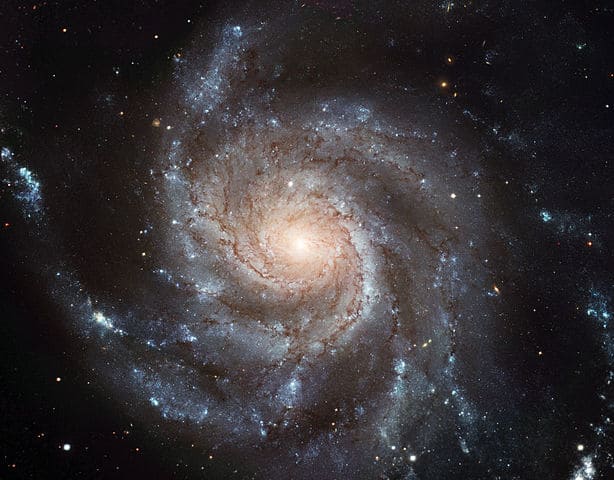
He grouped them into four main categories: spiral galaxies, lenticular galaxies, elliptical galaxies, and irregular galaxies. Observations revealed that spiral galaxies were the most common type of galaxies found throughout the universe.
They have a flat, spinning disk with a central bulge surrounded by spiral arms. The spinning motion reaches speeds of up to hundreds of kilometers/miles per second. This usually can cause matter in the disk to take on a distinctive spiral shape, like a cosmic pinwheel. For example, our Milky Way, like many other spiral galaxies, has a linear, starry bar at its center.
Formation
Galaxies are thought to have been formed roughly 13 to 14 billion years ago. One hypothesis states that galaxies were born when vast clouds of gas and dust collapsed under their own gravitational pull, allowing stars to form.
A second hypothesis claims that the young universe contained many small "lumps" of matter, which clumped together to form galaxies. Hubble Space Telescope has photographed such lumps, which may be the precursors to modern galaxies.
According to this theory, most of the early large galaxies were spirals. But over time, many spirals merged to form elliptical galaxies. Galaxies go on to merge with one another to create even bigger galaxies. Our Milky Way, for example, will collide with the Andromeda galaxy in the far future.
Nonetheless, there are still open questions about how galaxies form. Some astronomers believe that galaxies usually form from smaller clusters of about one million stars, known as globular clusters. Other astronomers believe that galaxies formed first and later birthed globular clusters. When it comes to spiral galaxies, it is believed that the stellar halo, bulge, and disks formed at different times and through different mechanisms.
Structure - Characteristics
Usually, spiral galaxies contain a central bulge surrounded by a flat, rotating disk of stars. The bulge located in the center is made up of older, dimmer stars, and is thought to usually contain a supermassive black hole.
Around two-thirds of spiral galaxies also contain a bar structure through their center, the same as our Milky Way. The disk of stars orbiting the bulge tends to separate into arms that circle the galaxy. These spiral arms contain a wealth of gas and dust, thus many young stars are birthed in these regions. These young stars shine very brightly before their quick demise.
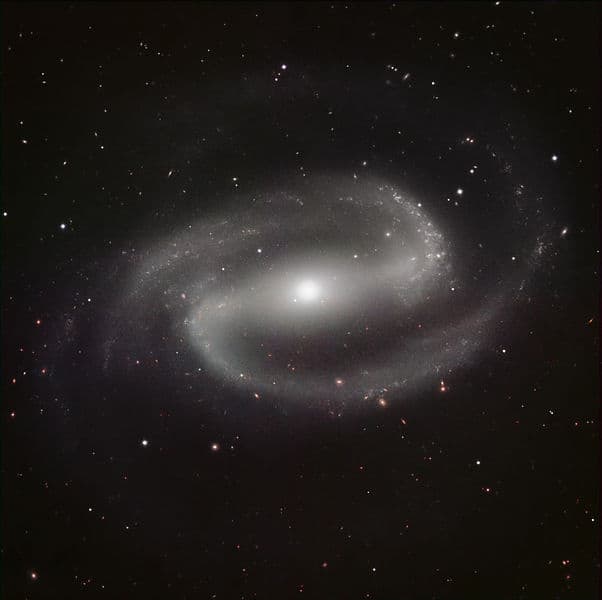
The motion of the spiral arms still remains disputed. A theory suggests that these galaxy arms could be the result of density waves traveling through the outer disk. Encounters between galaxies may cause such waves as the mass of the smaller galaxy could affect the structure of the larger galaxy as they unite.
Their size usually varies greatly, from 5 up to 100 kiloparsecs across. The same can be said regarding their mass which typically is between 109 and 1012 solar masses, and luminosities ranging from 108 to 1011 time that of the Sun.
The vast majority of spiral galaxies rotate in the sense that the arms trail the direction of the spin.
Measurements of the rotation curves revealed that the orbital speed of the material in the disk does not fall off as expected if most of the mass is concentrated near the center.
Because of this, the visible portion of spiral galaxies is regarded as having only a small fraction of the total mass of the galaxy.
Thus it is concluded that spiral galaxies are surrounded by an extensive halo consisting mostly of dark matter.
Spiral Galaxies Classification
Spiral galaxies can be classified according to the tightness of their spiral, the lumpiness of their arms, and the overall size of their central bulge.
The relative amounts of gas and dust contained within these galaxies can portray these differences.
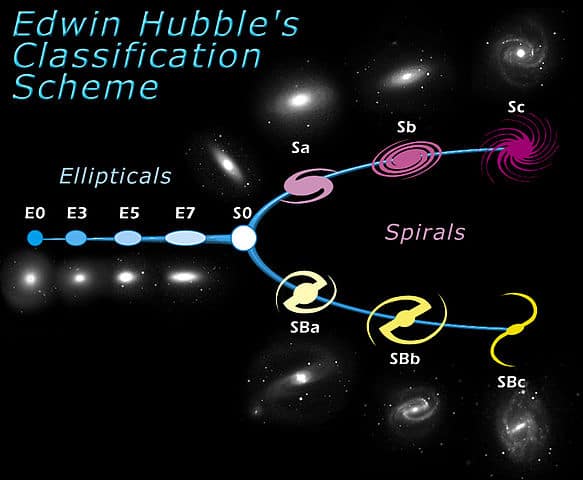
There are currently 3 classifications of classical spiral galaxies and another 3 for barred spiral galaxies:
1. Spiral galaxy type A – abbreviation Sa – they have a big central bulge and smooth, broad spiral arms. Around 2% of the mass of Sa spiral galaxies is present in the form of gas and dust. This means that a relatively small proportion of Sa galaxies are involved in star formation.
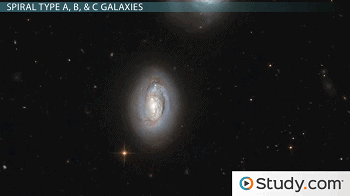
2. Spiral galaxy type B – abbreviation Sb – have a moderately-sized central bulge and moderately-well-defined spiral arms.
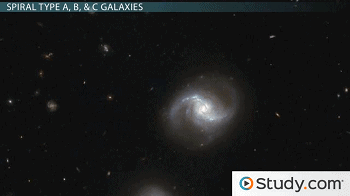
3. Spiral Galaxy type C – abbreviation Sc – small central bulge as well as narrow and well-defined central arms. They contain about 15% gas and dust.

4. Barred spiral galaxy type A – abbreviation SBa – they feature tightly bound arms.
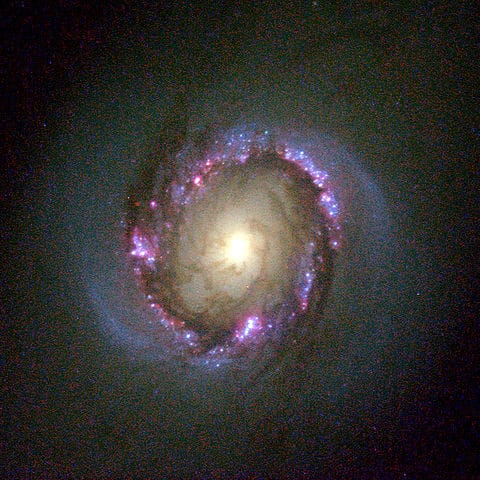
5. Barred spiral galaxy type B – abbreviation SBb – they feature both tightly and loosely bond arms.
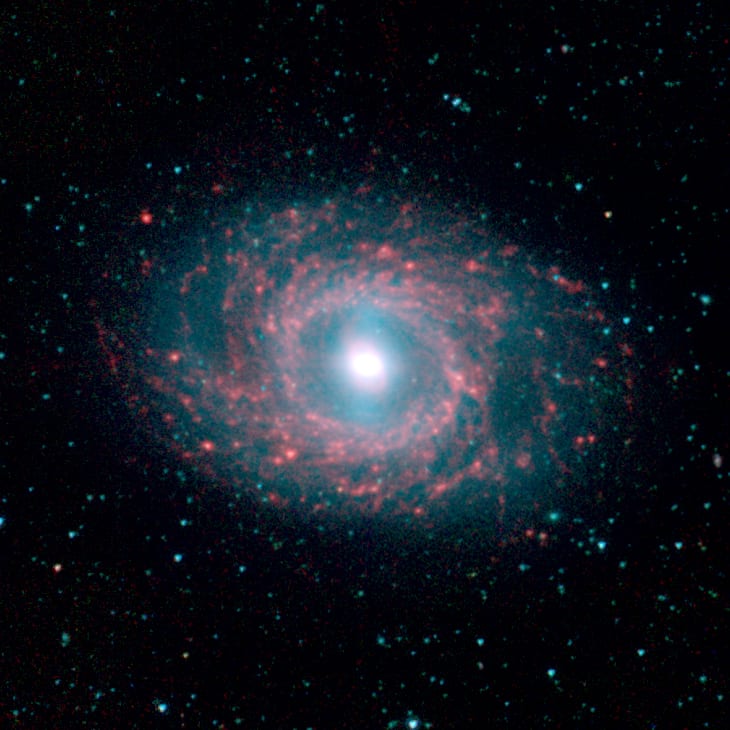
6. Barred spiral galaxy type C – abbreviation Sbc – they have loosely bound arms.
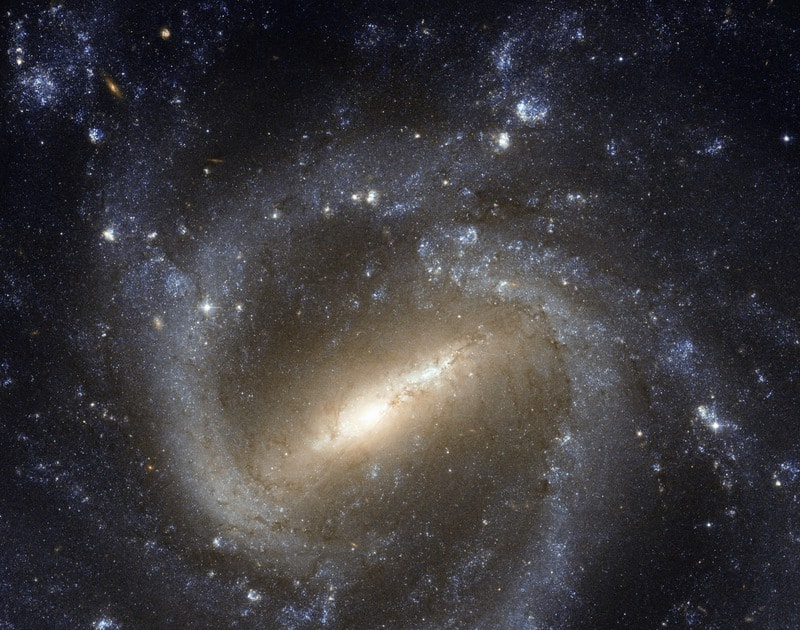
Future
Usually, spiral galaxies are believed to evolve into elliptical galaxies as they get older. All galaxies change their form/shape as they age. Usually, with time, galaxies collided with one another and former bigger structures.
Did you know?
- One of the largest spiral galaxies ever discovered is NGC 6872. It is around 522.000 light-years across from the tips of its outstretched arms.
- One of the oldest spiral galaxy to be discovered is the 11-billion-year-old A1689B11
- The nearest spiral galaxy to the Milky Way is the Andromeda galaxy at a distance of 2.5 million light-years away. It is also constantly moving closer to us and astronomers predict that these galaxies will collide in the far future.
- Around 77% of the galaxies that have been observed by man are spiral galaxies.
- Spiral galaxies are also known as disk galaxies.
Sources:
Image source:
- https://upload.wikimedia.org/wikipedia/commons/thumb/c/c5/M101_hires_STScI-PRC2006-10a.jpg/614px-M101_hires_STScI-PRC2006-10a.jpg
- https://upload.wikimedia.org/wikipedia/commons/thumb/3/36/HAWK-I_NGC_1300.jpg/602px-HAWK-I_NGC_1300.jpg
- https://upload.wikimedia.org/wikipedia/commons/thumb/2/21/HubbleTuningFork.jpg/583px-HubbleTuningFork.jpg
- https://study.com/cimages/multimages/16/c6fd58da-00d7-4ee4-bf6c-4633c452386b_untitled.png
- https://study.com/cimages/multimages/16/299d2ab1-c7bd-46e5-ac83-dce1d1a5e1da_untitled.png
- https://study.com/cimages/multimages/16/ebc96356-1677-4bf7-9214-6598a2521406_untitled.png
- https://upload.wikimedia.org/wikipedia/commons/thumb/3/39/NGC_4314HST1998-21-b-full.jpg/480px-NGC_4314HST1998-21-b-full.jpg
- https://en.wikipedia.org/wiki/Messier_95#/media/File:Messier95_spitzer.jpg
- https://en.wikipedia.org/wiki/NGC_1073#/media/File:Barred_spiral_galaxy_NGC_1073_(captured_by_the_Hubble_Space_Telescope).tif
